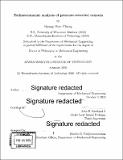Technoeconomic analysis of pressure-retarded osmosis
Author(s)
Chung, Hyung Won.
Download1155111852-MIT.pdf (13.17Mb)
Alternative title
Technoeconomic analysis of PRO
Other Contributors
Massachusetts Institute of Technology. Department of Mechanical Engineering.
Advisor
John H. Lienhard, V.
Terms of use
Metadata
Show full item recordAbstract
Pressure-retarded osmosis (PRO) is a renewable method of power production from salinity gradients which has generated significant academic and commercial interest. Because PRO is a non-intermittent technology (i.e., the energy output can be actively controlled) and it has huge global capacity (1.4-2.6 TW global salinity gradient power potential), a successful commercialization of PRO can significantly impact the global energy landscape. However, the current status quo has too low energy efficiency and too high capital cost for PRO to be successfully implemented on a large scale. A broad objective of this thesis is to analyze PRO from a system-level perspective to identify major bottlenecks and propose methods to remove these bottlenecks and improve system-level performance. Economic analysis is necessary to ascertain the practical viability of a PRO system for power production, but high complexity and the lack of large scale data has limited such work. Ve provide two methods to overcome such difficulty. First, we investigate lower bound cost scenarios for power generation with PRO to evaluate its economic viability. We build an economic model for PRO with assumptions that minimize the cost of power production, thereby conclusively identifying the operating conditions that are not economically viable. Second, we develop a simple yet powerful economic framework to relate the lower bound of levelized cost of electricity (LCOE) to net power density. A set of simplifying assumptions are used to develop an inverse linear relationship between net power density and LCOE. While net power density can be inferred based on experimentally measured power density, LCOE can be used to judge the economic viability of the PRO system. The minimum required net power density for PRO system to achieve an LCOE of $0.074/kWh (the capacity-weighted average LCOE of solar PV in the U.S.) is found to be 56.4 W/m2 Finally, we investigate multistage configurations of PRO as a viable way to improve net power density. We develop a unifying framework to classify and analyze various multistage designs in the literature. Then we identify the optimal multistage configuration that achieves most of the benefit of multistaging without significantly increasing the design complexity.
Description
Thesis: Ph. D., Massachusetts Institute of Technology, Department of Mechanical Engineering, 2020 Cataloged from PDF version of thesis. Includes bibliographical references (pages 105-111).
Date issued
2020Department
Massachusetts Institute of Technology. Department of Mechanical EngineeringPublisher
Massachusetts Institute of Technology
Keywords
Mechanical Engineering.